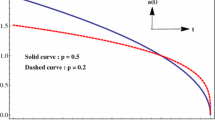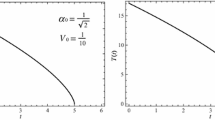Abstract
We consider a “Scalar-Maxwell–Einstein–Gauss–Bonnet” theory in four dimension, where the scalar field couples non-minimally with the Gauss–Bonnet (GB) term. This coupling with the scalar field ensures the non topological character of the GB term. In such higher curvature scenario, we explore the effect of electromagnetic field on scalar field collapse. Our results reveal that the presence of a time dependent electromagnetic field requires an anisotropy in the background spacetime geometry and such anisotropic spacetime allows a collapsing solution for the scalar field. The singularity formed as a result of the collapse is found to be a curvature singularity which may be point like or line like depending on the strength of the anisotropy. We also show that the singularity is always hidden from exterior by an apparent horizon.

Similar content being viewed by others
References
Oppenheimer, J.R., Snyder, H.: Phys. Rev. 56, 455 (1939)
Datt, B.: Z. Phys. 108, 314 (1938). (Reprinted as a Golden Oldie, Gen. Relativ. Gravit., 31, 1615 (1999))
Joshi, P.S.: Global Aspects in Gravitation and Cosmology. Clarendon Press, Oxford (1993)
Joshi, P.S. arXiv:1305.1005
Christodoulou, D.: Commun. Math. Phys. 109(591), 613 (1987)
Christodoulou, D.: Ann. Math. 140, 607 (1994)
Goncalves, S., Moss, I.: Class. Quantum Gravity 14, 2607 (1997)
Giambo, R.: Class. Quantum Gravity 22, 2295 (2005)
Goncalves, S.: Phys. Rev. D 62, 124006 (2000)
Goswami, R., Joshi, P.S.: Mod. Phys. Lett. A 22, 65 (2007)
Ganguly, K., Banerjee, N.: Pramana 80, 439 (2013)
Cai, R.G., Ji, L.W., Yang, R.Q.: Commun. Theor. Phys. 65(3), 329–334 (2016)
Cai, R.G., Ji, L.W., Yang, R.Q.: Commun. Theor. Phys. 68(1), 67 (2017)
Cai, R.G., Yang, R.Q. arXiv:1602.00112
Cai, R.G., Yang, R.Q. arXiv:1512.07095
Gundlach, C.: Critical phenomena in gravitational collapse: living reviews. Living Rev. Rel. 2, 4 (1999)
Goswami, R., Joshi, P.S.: Phys. Rev. D. 65, 027502 (2004)
Chakrabarti, S.: Gen. Relativ. Gravit. 49, 24 (2017)
Banerjee, N., Chakrabarti, S.: Phys. Rev. D 95, 024015 (2017)
Goldwirth, D., Piran, T.: Phys. Rev. D 36, 3575 (1987)
Choptuik, M.W.: Phys. Rev. Lett. 70, 9 (1993)
Brady, P.R.: Class. Quantum Gravity 11, 1255 (1995)
Gundlach, C.: Phys. Rev. Lett. 75, 3214 (1995)
Bekenstein, J.D.: Phys. Rev. D 4, 2185 (1971)
Oppenheimer, J., Volkoff, G.: Phys. Rev. 55, 374 (1939)
Rosales, L., Barreto, W., Peralta, C., Rodriguez-Mueller, B.: Phys. Rev. D 82, 084014 (2010)
Thorne, K.S.: Phys. Rev. 138, B251 (1965)
Ardavan, H., Partovi, M.H.: Phys. Rev. D 16, 1664 (1977)
Stein-Schabes, J.A.: Phys. Rev. D 31, 1838 (1985)
Germani, C., Tsagas, C.G.: Phys. Rev. D 73, 064010 (2006)
Herrera, L., Santos, N.O.: Phys. Rep. 286, 53 (1997)
Di Prisco, A., Herrera, L., Denmat, G.L., MacCallum, M.A.H., Santos, N.O.: Phys. Rev. D 76, 064017 (2007)
Sharif, M., Bhatti, M.Z.: Gen. Relativ. Gravit. 44, 281 (2012a)
Sharif, M., Bhatti, M.Z.: Mod. Phys. Lett. A 27, 1250141 (2012b)
Sharif, M., Yousaf, Z.: Can. J. Phys. 90, 865 (2012)
Banerjee, N., Paul, T.: Eur. Phys. J. C 77(10), 672 (2017)
Nojiri, S., Odintsov, S.D.: Phys. Rep. 505, 59–144 (2011)
Nojiri, S., Odintsov, S.D., Oikonomou, V.K.: Phys. Rep. 692, 1–104 (2017)
Sotiriou, T.P., Faraoni, V.: Rev. Mod. Phys. 82, 451–497 (2010)
De Felice, A., Tsujikawa, S.: Living Rev. Relativ. 13, 3 (2010)
Paliathanasis, A.: Class. Quantum Gravity 33(7), 075012 (2016)
Nojiri, S., Odintsov, S.D.: Phys. Lett. B 631, 1–6 (2005)
Nojiri, S., Odintsov, S.D., Gorbunova, O.G.: J. Phys. A 39, 6627 (2006)
Cognola, G., Elizalde, E., Nojiri, S., Odintsov, S.D., Zerbini, S.: Phys. Rev. D 73, 084007 (2006)
Maeda, H.: Phys. Rev. D 73, 104004 (2006)
Deppe, N., Leonard, C.D., Taves, T., Kunstatter, G., Mann, R.B.: Phys. Rev. D 86, 104011 (2012)
Lanczos, C.: Z. Phys. 73, 147 (1932)
Lanczos, C.: Ann. Math. 39, 842 (1938)
Lovelock, D.: J. Math. Phys. 12, 498 (1971)
Banerjee, N., Paul, T.: Eur. Phys. J. C 78(2), 130 (2018)
Goswami, R., Nzioki, A.M., Maharaj, S.D., Ghosh, S.G.: Phys. Rev. D 90, 084011 (2014)
Chakrabarti, S., Banerjee, N.: Eur. Phys. J. C 77, 166 (2017)
Chakrabarti, S., Banerjee, N.: Gen. Relativ. Gravit. 48, 57 (2016)
Nojiri, S., Odintsov, S.D., Sasaki, M.: Phys. Rev. D 71, 123509 (2005)
Chakraborty, S., SenGupta, S.: Phys. Rev. D 89(2), 026003 (2014)
Joshi, P.S., Goswami, R., Dadhich, N.: Phys. Rev. D 70, 087502 (2004)
Nolan, B.C., Nolan, L.V.: Class. Quantum Gravity 21(15), 3693 (2004)
Kompaneets, A.S.: Zh. Eksp. Teor. Fiz. 34, 953 (1958). (Sov.Phys. JETP 7 659, (1958))
Jordan, P., Ehlers, J., Kundt, W.: Abh. Akad. Wiss. Mainz. Math. Naturwiss. Kl 2, 21–85 (1960)
Author information
Authors and Affiliations
Corresponding author
Additional information
Publisher's Note
Springer Nature remains neutral with regard to jurisdictional claims in published maps and institutional affiliations.
Appendix I: Situation of isotropic spacetime
Appendix I: Situation of isotropic spacetime
The non static isotropic metric ansatz is taken as,
with a(t) is the scale factor of the spacetime characterized by the coordinates t (\(=x^0\)), r (\(=x^1\)), \(\theta \) (\(=x^2\)) and z (\(=x^3\)) where t is the timelike one. Moreover the scalar field and the electromagnetic field are considered to be dependent only on t. Therefore \(F_{\mu \nu }\) has three non zero independent components: \(F_{01}\), \(F_{02}\) and \(F_{03}\). With these non zero components of \(F_{\mu \nu }\), we obtain various components of \(T_{\mu \nu }(A)\) from Eq. (3) and are given by,
Using the above expressions of \(T_{\mu \nu }(A)\), the non diagonal components of gravitational equation are simplified to the following form:
which has the solution as \(F_{01} = F_{02} = F_{03} = 0\). Thus a spatially flat isotropic spacetime cannot support the time dependent electromagnetic field. However a Bianchi-I spacetime, although it is spatially flat, can sustain the gauge field by virtue of its anisotropy.
Rights and permissions
About this article
Cite this article
Banerjee, N., Paul, T. Electromagnetic effect on scalar field collapse in higher curvature gravity. Gen Relativ Gravit 51, 91 (2019). https://doi.org/10.1007/s10714-019-2574-6
Received:
Accepted:
Published:
DOI: https://doi.org/10.1007/s10714-019-2574-6




